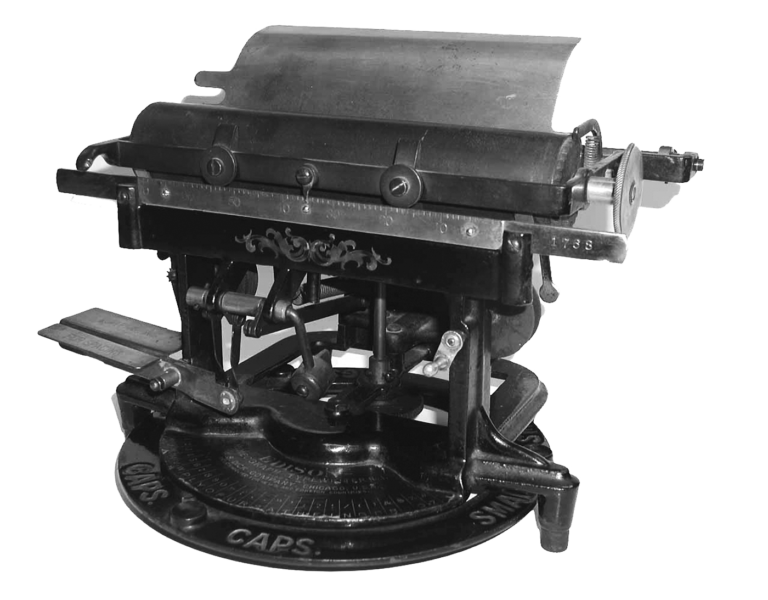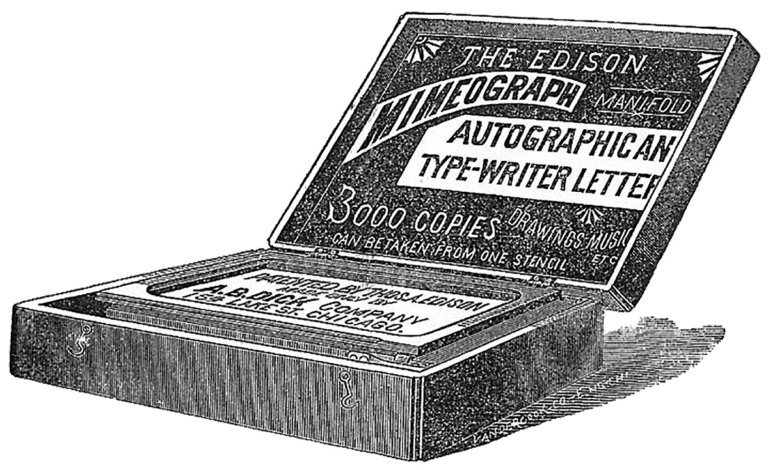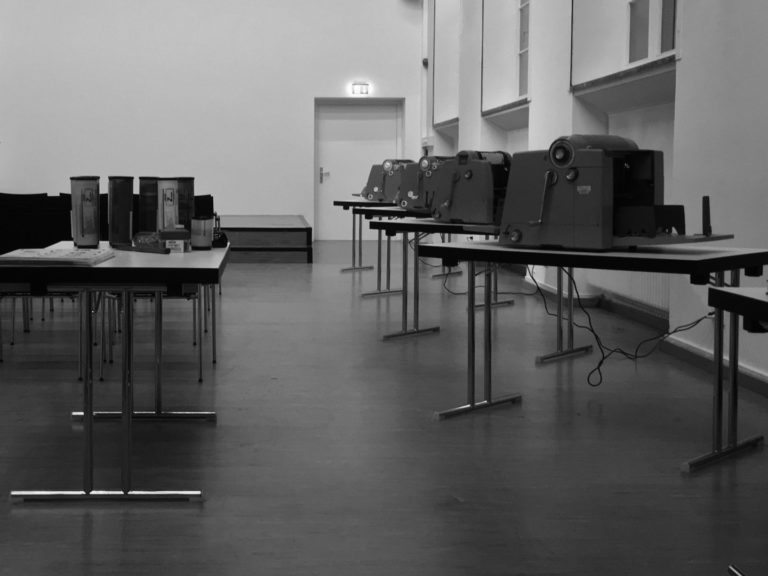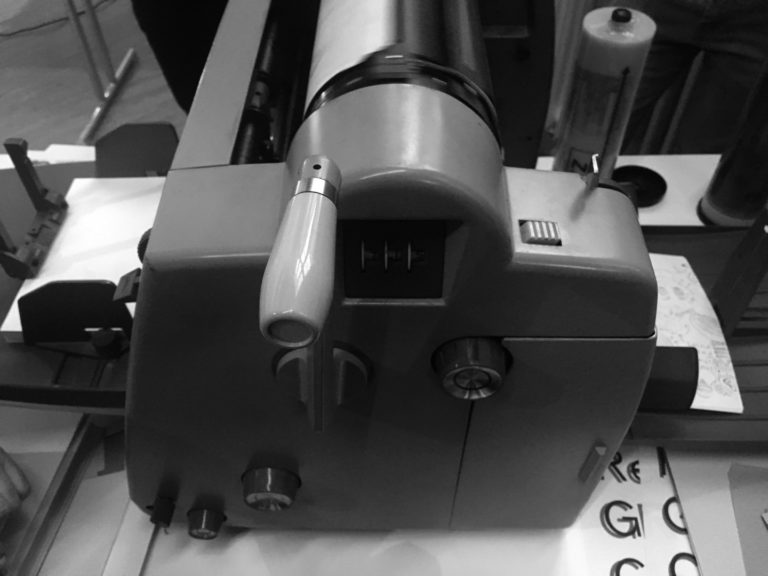B
It is certainly no coincidence that these duplication mechanisms arose particularly within the Industrial Revolution. On the contrary, with the advent of the machine age, not only were all trades expanded to include technical aids, but many continued to be supported or continued by machine. From that time, printing and copying companies could multiply their output. In addition and in contrast to traditional printing processes, there was no need to work with setting boxes or external specialists, making this type of duplicator accessible to many people.
 1
Ad for the Edison Mimeograph Typewriter Model 1, 1889; Picture owned by the Early Office Museum
1
Ad for the Edison Mimeograph Typewriter Model 1, 1889; Picture owned by the Early Office Museum
 2
Edison Mimeograph Typewriter Model 1, 1891; Picture owned by Anthony Casillo
2
Edison Mimeograph Typewriter Model 1, 1891; Picture owned by Anthony Casillo
Mimeographs were used together with spirit printers and hectographs in office work, in classrooms or to print political and church announcements. Theory writings, such as the “Critical Theory” by Theodor W. Adorno, were printed in the first edition on a mimeograph. James Schmidt, Professor für Geschichte, Philosophie und Politikwissenschaften an der Boston University schreibt dazu: „Its title [Philosophische Fragmente] confessed what its unusual form of dissemination implied: here was a collection of fragments, incomplete and perhaps even contradictory, with an identity rather different from more conventional products of the publishing industry.“ Later, early versions of fanzines were also printed using this technology because it was widely used and cheap. In the late 1960s, mimeographs, alcohol printers and hectographs were gradually replaced by photocopiers, so the mimeograph was the union of many inventions that existed so far.
The now insolvent “A. B. Dick Company bought some marketing rights to print patents from Thomas Alva Edison in the 1880s and refined this technique to the already mentioned mimeography. Edison, an inventor and entrepreneur specializing in electricity and electrical engineering, already gathered some reputation through his inventions. In 1875, Edison, inspired by his work on telegraph technology, began to develop the electric pen and laid the foundation for this development with electrical printing and copying techniques.
The electric pen was Edisons first product for the mass market. The electrically moved needle in the pen perforates a template when writing or drawing, which then can be used as a template for duplication. The first production-ready product of the A. B. Dick Company was sold in 1887 under the name “Model 0” and cost $12, which is equivalent to about $294.85 in 2017 according to a converter.
 1
Thomas Edison's patent (US 295 990) to the electric typewriter 1884, which he registered in 1871
1
Thomas Edison's patent (US 295 990) to the electric typewriter 1884, which he registered in 1871
 2
S. F. O'Reilly's patent (US 295,990) to the electric pen in 1891, he began in the mid-1880s with tattooing and also planned exhibitions
2
S. F. O'Reilly's patent (US 295,990) to the electric pen in 1891, he began in the mid-1880s with tattooing and also planned exhibitions
 3
Eugenio De Zuccaratos patent (US 498 149) for stencil production, 1891. The invention was made in 1874
3
Eugenio De Zuccaratos patent (US 498 149) for stencil production, 1891. The invention was made in 1874
While flat bed implements were first used in 1887, they were later replaced by rotating cylinder machines, just as the models made by Gestetner, named after the Hungarian inventor David Gestetner in England, also sold by the name “Cylostyle”.
. This machine was the first to place the paper on a flatbed and pass underneath the rotating ink rollers. This process paved the way for a more automated, faster reproduction, with the pages fed through the rollers and moved through the machine rather than always printing on a single sheet of paper. Gestetner was working on the Vienna Stock Exchange at that time and had to write down the stock market reports daily. From this activity, he developed the first copier, which was written on a wax stencil instead of paper and this was used as a master copy. Gestetner then went to London, where he founded the “Gestetner Cyclograph Company” in 1881, which made the templates and the pens for his process. By further development of the process, it was already possible in 1890 to produce 1200 copies per hour. His 1881 patented Cyclostyle was and is popularly known as Gestetner.
The process that is underlying Cyclostyle is always similar: Waxed papers are perforated before printing with a thin pen so that color comes through the paper when printed on. The most interesting fact about David Gestetner’s machines was that they were much better equipped than the American variants that existed at the time: while American mimeos distributed paint using internal brushing and centrifugal force, David Gestetner used the far more sophisticated system of “wavering roles.” In addition, the Gestetner machines also had more sophisticated methods to improve the registration of color separations, which was well suited for two- and three-color mimeograph work.
Finally, in 1906, the Gestetner plants in Tottenham, north of London, underlined the reach of this invention, long before 1929, when none other than the young American industrial designer Raymond Loewy was hired to improve the mimeograph’s appearance and branding.
Meanwhile, the A.B. Dick Company was able to sell about 20.000 devices in the United States alone until 1889 and thus established the copying technology in companies and authorities of the then young nation, while Edison’s own devices were considered too technical and thus he was able to sell far fewer devices.
 1
Exhibition of Gestetner devices, 1932; Image owned by the Pacific National Exhibition Fund
1
Exhibition of Gestetner devices, 1932; Image owned by the Pacific National Exhibition Fund
 2
Gestetner Automatic Cyclostyle (French advertising for the British hectograph), around 1900; Picture owned by the Early Office Museum
2
Gestetner Automatic Cyclostyle (French advertising for the British hectograph), around 1900; Picture owned by the Early Office Museum
 3
Advertising for the Holcomb Transfer Tablet Hectographers (1876); Picture owned by the Early Office Museum
3
Advertising for the Holcomb Transfer Tablet Hectographers (1876); Picture owned by the Early Office Museum
 1
A series of Gestetner models 366 and 420 at a workshop with Erwin Blok, a restorer of old mimeographs at the Stuttgart State Academy of Fine Arts. Today these are operated with colors of the company RISO.
1
A series of Gestetner models 366 and 420 at a workshop with Erwin Blok, a restorer of old mimeographs at the Stuttgart State Academy of Fine Arts. Today these are operated with colors of the company RISO.
 2
A Gestetner Mimeograph restored by Erwin Blok during the printing process
2
A Gestetner Mimeograph restored by Erwin Blok during the printing process










